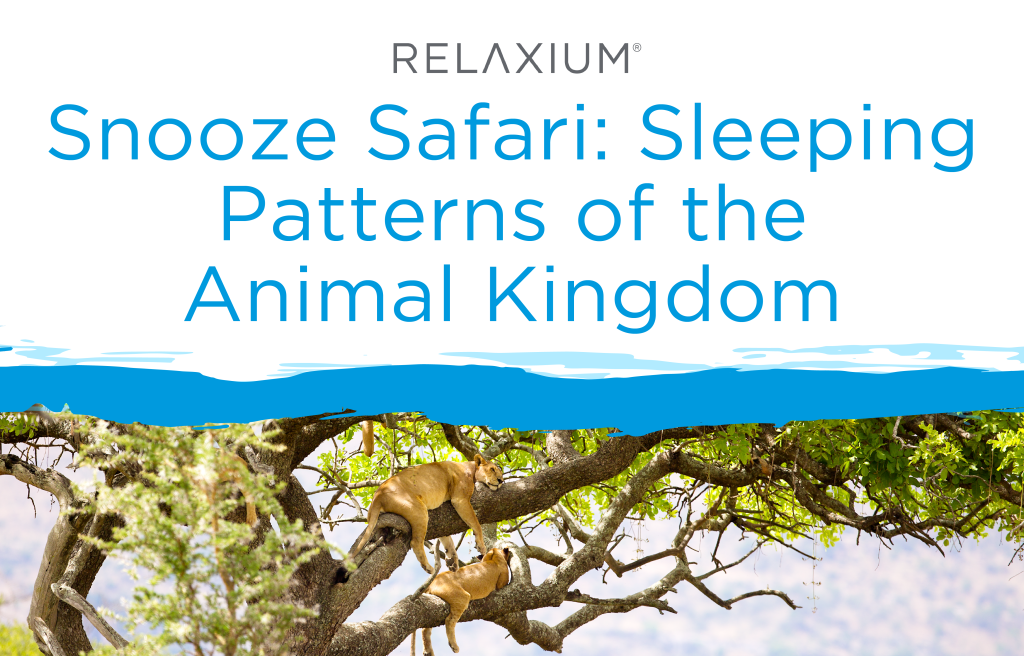Embark on our Snooze Safari, where we will delve into the fascinating sleeping habits of the animal kingdom!
Have you ever wondered what sleep schedules the animals in our world follow? Being that they don’t follow a social pattern of society like us, their sleeping habits are scattered across the board.
We are going to break it into sections of
- Mammals
- Birds
- Reptiles
- Insects
- Marine animals
This is different from other blogs we have written for you but we hope you enjoy it! Maybe you’ll pick up a new fun fact you can tell others.
Mammals
The warm-blooded animals in the animal kingdom, the group of mammals is quite diverse. Mammals will typically have fur, can produce milk for their young, and can regulate their body temperature internally.
There are more than 5,400 species of mammals, a few of these orders include:
- Primates: Humans, apes, monkeys
- Rodents: Mice, rats, squirrels, beavers
- Carnivores: Dogs, cats, weasels, hyenas
- Bats: Mammals that can fly
- Ungulates: Hoofed mammals such as horses, cows, deer, and pigs
- Marsupials: Mammals that carry their young in their pouches such as kangaroos and koalas
- Edentates: Mammals with no or few teeth such as sloths and anteaters
Mammals stick to consolidated sleep, which means several hours of sleep each night. Some mammals though have evolved so much which has led them to thrive in some environments.
Bats for example have a hemisphere of the brain that allows them to maintain essential sensory awareness when asleep.
One of the world’s most intimidating mammals, the lion has an interesting sleeping pattern. Lions will actually sleep around 16-20 hours each day. Though this may seem like a lot, lions actually don’t sleep all at once. They follow a polyphasic sleep pattern which means they sleep in bursts so they can maintain their social structure. By following this kind of sleep, they can continue to communicate with their pride.
Birds
Birds are another group of warm-blooded animals that also happen to have feathers. They belong to the class, Aves. Birds of course are different considering their unique features of wings that help them fly, beaks for their diets, and a lightweight skeletal structure. Birds are actually endothermic which means they regulate their body temperatures internally.
There are more than 10,000 species of birds that can be found in many different habitats such as air, land, and even oceans.
There are several groups that birds fall into. The most common include:
- Waterbirds: ducks, geese, swans
- Passerines: Sparrows, finches, warblers
- Raptors: Eagles, hawks, owls
- Gamebirds: Birds hunted for sport which include pheasants, grouse, and quail
- Parrots: Birds with brightly colored feathers and powerful beaks; parrots, macaws, cockatoos
- Pigeons and doves: Bird with plump bodies and small heads
As far as sleep goes, birds are very unique in the way they sleep. They sleep in short bursts throughout both the day and night. The sleep category they fall into is “unihemispheric slow-wave sleep,” (USWS).
Like the bats we mentioned, birds also have a hemisphere that remains active when sleeping which allows them to be alerted when potential predators arrive. Birds do not sleep on their sides or stomach, rather they sleep perched, with their legs locked in position.

The birds we listed that are on the water can actually sleep when floating on the water. They will typically tuck their beaks into their feathers and close only one eye so they can still be aware of their surroundings.
Some birds can even sleep in flight! Flying while still avoiding obstacles. Isn’t that convenient?
Reptiles
One of the oldest known species is reptiles. Reptiles are cold-blooded animals that have a more scaly, hard exterior. There are more than 10,000 species of reptiles which are scattered across the world; land, oceans, and freshwater environments.
They can be broken up into several groups which include:
- Squamata: Lizards, and snakes; those with elongated bodies and scaly skin.
- Testudines: Turtles and tortoises, those that have a bony shell for protection.
- Crocodilia: Just as it sounds, crocodiles, alligators, and caimans. Those who have a long snout and powerful jaws.
- Sphenodontia: You may have never heard of this, but Tuataras fall into this category. They look like lizards but are only found in New Zealand.
An interesting fact about a common reptile, snakes is that they sleep by closing their eyes and remaining still, the interesting thing though is that snakes don’t have eyelids, but rather a transparent scale. This helps to cover their eyes and protect them from damage all while still being able to see.
Insects
Insects are a large group on our planet and are responsible for many things. There are over 1 million known species of insects. The typical characteristics of insects include having six legs, a three-part body, and sometimes wings.
Some of the major groups of insects include:
- Lepidoptera: Butterflies and moths
- Coleoptera: Beetles, ladybugs
- Hymenoptera: Ants, bees, wasps, and hornets
- Hemiptera: Stink bugs, cicadas, true bugs
- Orthoptera: Grasshoppers, crickets, katydids
- Odonata: Dragonflies, damselflies
- Isoptera: Termites
Bees actually sleep in groups. This is for defense purposes. Since bees live in hives among other bees, they will actually take turns guarding the other bees when they sleep. The bee that guards will stand at the entrance.

Marine animals
There are around 228,450 known species in the ocean. This section is interesting being that we have only discovered 5% of the oceans, so millions of other marine animals are still a total mystery.
The most common groups of marine animals are:
- Fish
- Sharks and rays
- Mammals
- Invertebrates
- Reptiles
You get a good mixture of species when it comes to the ocean. Fish are known to rest rather than sleep like other mammals. Like some birds, some fish are able to sleep while still swimming.
Sharks, one of the most misunderstood and feared marine animals actually need to swim to breathe. This makes their sleeping pattern rather interesting. Some sharks have learned to swim slowly while still moving so water can pass over their gills, helping them breathe. Some even sleep on the ground and move slowly to continue breathing. Sharks have a membrane called the nictitating membrane that covers their eyes to protect them while they sleep.

The world around us will continue to evolve
We hope this has been an interesting read; one where you can pull some facts the next time you’re at the zoo, or are simply outside!
Just like animals, we need our sleep as well. If you are struggling, consider our safe and effective supplement, Relaxium Sleep. Relaxium Sleep is a supplement designed to help you fall asleep faster, stay asleep longer, and have you waking up feeling refreshed and alert.
Relaxium offers a number of safe and effective supplements that aid in the categories of sleep, calm, focus, and immunity. Created by Clinical Neurologist and Sleep Expert, Dr. Eric Ciliberti, TryRelaxium.com offers a 30-day Money Back Guarantee trial of Relaxium Sleep to allow our users to truly experience its effects. To try the product today visit our website for more information.
To restful and healthy days ahead.
The Relaxium Team
*These statements have not been evaluated by the Food & Drug Administration. This product is not intended to diagnose, treat, cure, or prevent any disease.
Sources:
https://zooatlanta.org/why-do-lions-sleep-so-much/#:~:text=Lions%20Can%20Sleep%2020%20Hours,(n.d.).
https://animals.sandiegozoo.org/animals/tuatara
https://a-z-animals.com/blog/what-do-snakes-have-instead-of-eyelids/
https://www.annualreviews.org/doi/abs/10.1146/annurev-ento-020117-043348
https://bmcbiol.biomedcentral.com/articles/10.1186/s12915-021-01028-x

